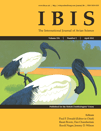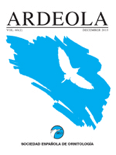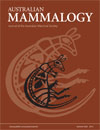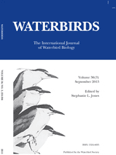
IBIS
Scope & Guideline
Advancing ecological knowledge since 1859.
Introduction
Aims and Scopes
- Avian Ecology and Behavior:
Research exploring the behavioral patterns, ecological interactions, and social structures of bird species across various habitats. - Conservation and Management:
Studies that address the conservation status of bird populations, management practices, and the effects of human activities on avian species. - Physiology and Development:
Investigations into the physiological processes, developmental stages, and health metrics of birds, often in relation to environmental stressors. - Migration and Dispersal:
Research examining migratory patterns, routes, and behaviors, including the impacts of climate change and habitat loss on migration. - Genetics and Evolution:
Studies focusing on the genetic diversity, phylogenetics, and evolutionary history of avian species, often using molecular techniques. - Citizen Science and Community Engagement:
Papers that utilize citizen science data to enhance ornithological research and promote public engagement in avian conservation. - Technological Innovations in Ornithology:
Research involving the application of new technologies, such as GPS tracking and bioacoustics, to study bird behavior and ecology.
Trending and Emerging
- Impact of Climate Change on Avian Species:
An increasing number of studies are focusing on how climate change affects migration patterns, breeding success, and habitat availability for birds. - Urban Ecology and Adaptation:
Research exploring how birds adapt to urban environments is gaining traction, reflecting the growing intersection of urbanization and conservation biology. - Technological Advances in Monitoring:
Utilization of advanced technologies, such as drone surveillance and automated acoustic monitoring, is trending, allowing for more accurate data collection on bird populations. - Health and Disease in Birds:
Emerging studies on the prevalence of diseases, the effects of pollutants, and health metrics in avian populations are increasingly being published, reflecting a holistic view of bird conservation. - Community Science Contributions:
The role of citizen science in ornithological research is expanding, with more papers highlighting data collected by the public and its implications for conservation efforts. - Behavioral Ecology in Changing Environments:
Research on how behavioral adaptations in birds are influenced by environmental changes is becoming a prominent theme, particularly in relation to resource availability.
Declining or Waning
- Historical Avifauna Studies:
Research focusing on historical bird populations and their changes over time, which has seen a decline as contemporary ecological studies gain precedence. - Traditional Taxonomy and Systematics:
While still relevant, the emphasis on traditional taxonomic classifications is waning in favor of molecular and genetic approaches that provide deeper insights into avian evolution. - Generalized Habitat Studies:
Studies that broadly categorize bird habitats without specific ecological metrics are less frequent, as there is a growing focus on detailed ecological interactions and management implications. - Single-Species Studies without Conservation Context:
Research focusing solely on individual species without linking to broader conservation outcomes is becoming less common, as integrative approaches are favored. - Static Population Assessments:
Static assessments of bird populations are declining in favor of dynamic models that consider environmental changes and anthropogenic impacts.
Similar Journals

JOURNAL OF ORNITHOLOGY
Connecting Science and Conservation for BirdsJOURNAL OF ORNITHOLOGY, published by Springer Heidelberg, is a leading international journal dedicated to the study of birds and their conservation. With an ISSN of 2193-7192 and an E-ISSN of 2193-7206, this journal serves as a crucial platform for disseminating innovative research focused on avian biology, ecology, and behavior, making significant contributions to the fields of Agricultural and Biological Sciences and Animal Science and Zoology, where it holds a commendable rank of #156 out of 490 in Scopus. Established from 2004 and continuing through 2024, the journal strives not only to advance academic scholarship but also to inform practical conservation efforts globally. While currently not open access, it remains a vital resource for researchers, professionals, and students seeking high-quality studies and findings that influence the understanding and preservation of bird species. The journal's commitment to excellence in science highlights its importance in ornithological research, offering insights that are both profound and actionable.

ORNIS FENNICA
Cultivating Knowledge for the Conservation of BirdlifeORNIS FENNICA, published by BirdLife Finland, is a seminal journal dedicated to the field of ornithology and avian ecology. Established in Finland, this journal has been a vital resource for researchers, professionals, and students since its inception, evolving through converged publication periods from 1979 to 1985 and again from 1991 to the present. ORNIS FENNICA holds a Q2 category ranking in Animal Science and Zoology for 2023, indicating its significant influence and reputation within the academic community, as reflected in its Scopus ranking of 242 out of 490 in its field. The journal aims to promote the study of birds, encompassing aspects such as behavior, conservation, and biodiversity, thus serving as a crucial platform for disseminating innovative research findings. Although it is not open access, ORNIS FENNICA remains committed to advancing ornithological knowledge and supporting the scientific community's efforts to understand and protect avian species. For those invested in the nuances of bird research, this journal offers an invaluable repository of scholarly articles, reviews, and insights.

ORNITOLOGIA NEOTROPICAL
Fostering collaboration in the study of avian diversity.ORNITOLOGIA NEOTROPICAL is a vital journal dedicated to advancing the field of Neotropical ornithology, published by the esteemed Neotropical Ornithological Society in collaboration with the USGS Patuxent Wildlife Research Center. With an ISSN of 1075-4377, this journal serves as a platform for researchers, professionals, and students to disseminate important findings related to avian biodiversity, ecology, and conservation in the Neotropical region. Although currently classified in Q4 quartiles for both Animal Science and Zoology and Ecology, Evolution, Behavior and Systematics, ORNITOLOGIA NEOTROPICAL has been gaining recognition since its inception in 2005. The journal promotes open discussions and rigorous methodologies that significantly contribute to the understanding and protection of avian species. By facilitating accessibility to cutting-edge research and fostering a collaborative scientific community, ORNITOLOGIA NEOTROPICAL aims to enhance the impact and importance of ornithological studies in the Neotropical domain.

AUSTRALIAN JOURNAL OF ZOOLOGY
Bridging Research and Conservation for Wildlife SuccessAustralian Journal of Zoology, published by CSIRO PUBLISHING, serves as a premier platform for research in the fields of animal science and zoology, with a profound commitment to advancing our understanding of wildlife and ecosystems. Featuring an ISSN of 0004-959X and an E-ISSN of 1446-5698, this esteemed journal encompasses a wide range of topics relevant to ecology, evolution, behavior, and systematics. For the year 2023, it holds a commendable Q2 ranking in both Animal Science and Zoology and Ecology, Evolution, Behavior, and Systematics, demonstrating its significant impact within the academic community. With a rich publication history spanning from 1952 to 2024, the journal caters to researchers, professionals, and students by disseminating crucial findings and methodologies that contribute to effective conservation efforts and informed ecological practices. Although not an open access journal, it continues to foster collaboration and discussion among scholars in Australia and beyond. Located in Clayton, Victoria, the journal remains dedicated to its objective of enhancing knowledge in zoological sciences and addressing vital environmental challenges.

MALIMBUS
Innovating conservation strategies for our feathered friends.MALIMBUS is a peer-reviewed journal published by the West African Ornithological Society, focusing on the study of avian biology and conservation. It aims to disseminate important research findings that contribute to the understanding of bird species, their habitats, and the challenges they face across West Africa and beyond. Although currently not available in an open-access format, the journal is an invaluable resource for ornithologists, ecologists, and industry professionals keen on advancing their understanding of avian science. Those engaged in research on bird migration, breeding behaviors, and conservation strategies will find MALIMBUS to be a vital platform for sharing innovative ideas and fostering collaborations. With its commitment to quality and rigorous review processes, MALIMBUS is an essential reference for anyone dedicated to studying and preserving avian diversity.

Ardeola-International Journal of Ornithology
Unveiling the Secrets of Bird BehaviorArdeola - International Journal of Ornithology, published by the SOCIEDAD ESPAÑOLA DE ORNITOLOGÍA, serves as a vital platform for the dissemination of research in the field of avian studies. With a history dating back to 1980, this esteemed journal has cultivated a reputation for high-quality research, achieving a notable Q2 category ranking in Animal Science and Zoology as well as in Ecology, Evolution, Behavior, and Systematics as of 2023. While primarily based in Spain, Ardeola caters to a global audience, providing essential insights into ornithology through rigorously peer-reviewed articles. The journal does not currently operate under an open-access model, which underscores the significance of institutional subscriptions and the importance of supporting academic publishing. Researchers, professionals, and students engaged in avian ecology will find Ardeola indispensable for accessing impactful studies that advance our understanding of bird populations, behaviors, and conservation issues. With its accessibility and continuing commitment to excellence, Ardeola plays a crucial role in fostering knowledge and promoting dialogue in the ornithological community.

OSTRICH
Fostering Innovation in Avian Biology and EcologyOSTRICH, a distinguished journal published by Taylor & Francis Ltd, serves as a pivotal platform for disseminating research in the fields of ecology, evolution, behavior, and systematics. With an ISSN of 0030-6525 and an E-ISSN of 1727-947X, this journal has been contributing vital insights to the scientific community since its inception in 1930. Maintained in the UK, OSTRICH holds a respectable Q3 category ranking in the 2023 Ecology, Evolution, Behavior, and Systematics quartiles and ranks 408th out of 721 within its scientific domain according to Scopus, showcasing a competitive position within the 43rd percentile. OSTRICH is committed to publishing high-quality research that informs conservation efforts and biodiversity studies, making it an essential resource for researchers, professionals, and students interested in avian biology and related ecological fields. While not currently an open-access journal, OSTRICH offers varied access options through institutions and libraries, further widening its reach and impact within the scientific community. We invite academics and practitioners to explore its valuable articles that drive forward innovations in avian research.

AUSTRALIAN MAMMALOGY
Illuminating the Interactions of Mammals and Their EcosystemsAustralian Mammalogy, published by CSIRO PUBLISHING, is a pivotal journal in the fields of Animal Science and Zoology as well as Ecology, Evolution, Behavior and Systematics. With its ISSN 0310-0049 and E-ISSN 1836-7402, this esteemed journal has been instrumental in disseminating critical research findings since 2000, and continues to evolve up to 2024. Ranked in the Q2 quartile of both its categories for 2023, it showcases a diverse array of studies that contribute to understanding Australia’s unique mammalian fauna and its ecological dynamics. Researchers, professionals, and students will find valuable insights in its peer-reviewed articles, which are essential for advancing knowledge in these essential scientific disciplines. Located in Australia at UNIPARK, Locked Bag 10, Clayton, VIC, this journal remains committed to fostering scholarly communication within the global scientific community.

WATERBIRDS
Exploring the Depths of Avian ScienceWATERBIRDS, published by the WATERBIRD SOC, serves as a vital scholarly resource in the field of Animal Science and Zoology. With its ISSN 1524-4695 and E-ISSN 1938-5390, this journal has established a significant presence since its inception in 1996, continuing to contribute valuable insights and research up to 2024. Recognized for its impact within the academic community, WATERBIRDS is currently positioned in the third quartile (Q3) for its category in 2023, ranking 335 out of 490 in Scopus's Agricultural and Biological Sciences sector, which underscores its role in promoting the study of avian species and their habitats. The journal is accessible to a wider audience, aligning with the growing demand for open access to scientific knowledge. By disseminating research that addresses both ecological and conservation issues pertinent to waterbirds, this publication serves as an essential platform for researchers, professionals, and students dedicated to advancing the understanding of avian biology and related fields.

NOTORNIS
Exploring the intricacies of birdlife and ecology.NOTORNIS is a prestigious academic journal published by the Ornithological Society of New Zealand, dedicated to advancing the field of ornithology and contributing meaningful research related to avian species. With ISSN 0029-4470 and E-ISSN 1177-7680, this journal has been a vital resource for scholars since its inception in 1982, continuously fostering discourse within the scientific community, particularly in the realms of animal science and zoology. Though it currently holds a quartile ranking of Q4, with a Scopus rank of #250 out of 490 in its category, NOTORNIS occupies a unique niche in ornithological research, promoting studies that highlight the ecological and biological intricacies of birds. This journal is critical not only to researchers and professionals in zoology but also to students and educators aiming to engage with contemporary avian research. As New Zealand's leading ornithological publication, NOTORNIS underscores the importance of avifaunal studies in conserving biodiversity and understanding ecological dynamics.